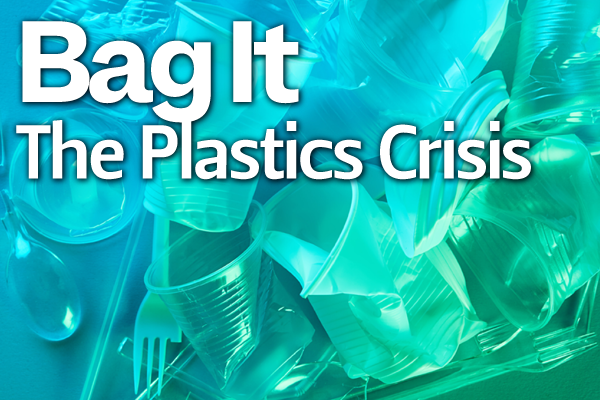Diet for a Sick Planet: Studies Find More Plastic in Our Food and Bottled Water
If we are what we eat, there’s growing evidence to help explain how nanoplastics and microplastics are in our blood, in our intestines and in some of our organs.
Two new studies published this week shed further, and alarming, light on all the tiny plastic particles that people are consuming every day.
A liter of bottled water may contain nearly a quarter million pieces of the smallest particles of plastic. These nanoplastic particles are so small, scientists have found, that some pass through intestines and lungs or make their way into human blood and placental fluid. The bottled water study, done by researchers at Columbia and Rutgers Universities, was published Monday in the Proceedings of the National Academy of Sciences.

Also published Monday, in the journal Environmental Pollution, was a paper from scientists at the University of Toronto and the Ocean Conservancy, which found that nearly 90 percent of 16 different kinds of protein commonly eaten by people, including seafood, chicken and beef—and even plant-based meat alternatives such as tofu and veggie burgers—contain microplastics.
The scientists estimated that Americans are consuming up to 3.8 million particles of microplastics per year from protein alone.
“Our message is that you can’t hide,” said George Leonard, co-author of the Environmental Pollution paper and chief scientist at the Ocean Conservancy, an environmental nonprofit. “We need to know more about this, clearly,” and the health implications, he said. “There is zero chance that exposure to plastics is good for you. The question is, what is the magnitude of the risk and how do you minimize that?”
The two studies add to a global body of scientific research that has documented micro- and nanoplastics’ ubiquity in the world and increasingly in human bodies.
Researchers are still trying to understand the health implications, but many like Leonard have come to believe they’re not good.
Last year, the United Nations Environment Program counted 13,000 chemicals in plastic, many of them toxic. Chemical additives are used to give different kinds of plastic their own properties, such as flexibility, clarity and stretch.
The UNEP report, “Chemicals in Plastic,” noted that only half of the 13,000 chemicals in plastic have been screened for properties to know whether they are hazardous to people or the environment. But at least 3,200 of the 7,000 screened chemicals have been identified as potentially of concern, it concludes.
Some of those chemicals persist and accumulate in the environment, where they can wreak havoc on wildlife or people, including per- and polyfluoroalkyl substances (PFAS), which have been dubbed “forever chemicals.”
Toxic chemicals added to plastic and routinely detected in people are known to mimic hormones and increase the risk of miscarriage, obesity, cardiovascular disease and cancers, according to a report published last year by the Minderoo-Monoco Commission on Human Health, a body of scientists assembled by the Australia-based Minderoo Foundation, and published by Annals of Global Health, a peer-reviewed scientific journal. Plastic causes illness and death across its lifecycle, from production to use and disposal, the report concluded.
As plastic breaks up in the environment, it forms smaller and smaller particles.
Earlier studies had found microplastics in bottled water, but the bottled water study published Monday used new, more sensitive techniques that can identify the smallest plastic pieces, and found 10 to 100 times as many plastic fragments, according to a press release from Columbia’s Climate School.
“Previously this was just a dark area, uncharted,” said study co-author Beizhan Yan, an environmental chemist at the Climate School’s Lamont-Doherty Earth Observatory, in the release. “Toxicity studies were just guessing what’s in there. This opens a window where we can look into a world that was not exposed to us before.”
The protein study focused on slightly larger plastic fragments that still need to be seen under a microscope.
The food products were purchased in Portland, Oregon, and included breaded shrimp, minced pollock fish sticks, two kinds of shrimp, skinless Alaska Pollock fillets, chicken nuggets, top sirloin steaks, pork loin chops, chicken breasts, plant-based nuggets, plant-based fish sticks, plant-based ground beef and tofu blocks.
The samples were sent to a lab at the University of Toronto for analysis, where scientists found no statistical differences in the amount of microplastics in land-based proteins compared to ocean-based proteins.
But they found evidence that food processing is a likely source of microplastic contamination. Highly processed fish sticks, chicken nuggets, tofu, and plant-based burgers and others contained significantly more microplastics per gram than minimally processed products, such as the Alaska pollock or chicken breasts, according to the study.
“It’s tempting to want to draw conclusions like ‘eat less of this and more of that’ to avoid microplastics in your diet,” said primary co-author Madeleine Milne, who conducted the research while at the Rochman Lab at the University of Toronto in 2022, in a press release.
“But right now we still know very little about the microplastic burdens in commonly consumed foods,” she said. “Our study adds to this knowledge but also demonstrates the need for further research to better understand the bigger picture, including where these microplastics are coming from and the potential human health risks.”
The water bottle and protein studies come amid an attempt by more than 170 nations to negotiate a treaty to address the global crisis from the production of more than 400 million tons of plastic a year, nearly all from climate-warming fossil fuels, with a recycling rate of less than 10 percent.
The results of the protein study were not surprising to Jane Muncke, an environmental toxicologist and managing director and chief scientific officer of the Food Packaging Forum, a science communication organization based in Zurich.
“It’s well known that the normal and intended use of plastic food packaging leads to the generation of micro- and nanoplastics, when tearing open packaging,” she said.
It is also not surprising, she said, that increased food processing leads to higher levels of microplastics because microplastics are generated by abrasion from food processing equipment, and then transferred into the food. “More processing also leads to chemical migration,” she added.
“I welcome this study that highlights this issue and raises awareness for the need to act on it,” she said.
Leonard, a marine scientist, said in an interview that while a lot more needs to be known about how micro- and nanoplastics are affecting human health and the environment, it’s clear that action is needed to reduce plastic waste in society and the natural environment, including the ocean.
“And, we need to make and use a whole lot less plastic,” Leonard said.
Share this article
Disclaimer: The copyright of this article belongs to the original author. Reposting this article is solely for the purpose of information dissemination and does not constitute any investment advice. If there is any infringement, please contact us immediately. We will make corrections or deletions as necessary. Thank you.







